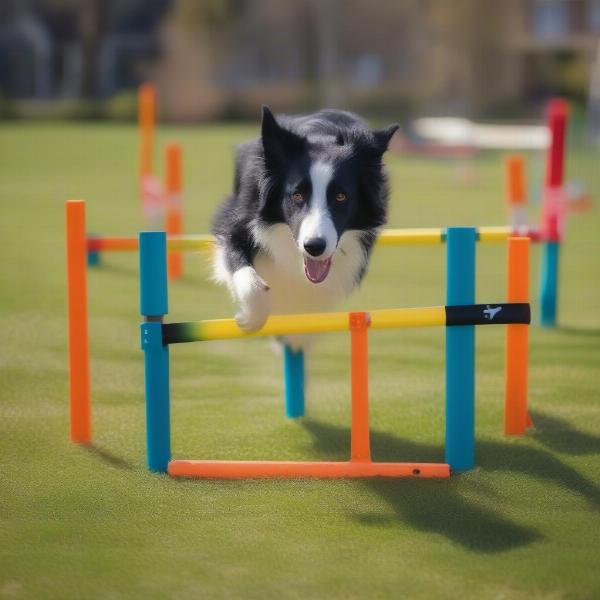Dog agility is a fantastic way to bond with your furry friend while providing them with physical and mental stimulation. Whether you’re a seasoned competitor or just starting out, a dog agility kit can be the perfect tool to introduce your dog to this exciting activity. Finding the right dog agility kit can be overwhelming, so we’ll cover everything from choosing the right equipment to setting up your own backyard course.
Choosing the Right Dog Agility Kit
The best dog agility kit for you depends on your dog’s size, breed, experience level, and your own backyard space. Consider these factors when selecting a kit:
- Dog Size and Breed: Smaller dogs will need equipment scaled to their size. Larger, more energetic breeds might require more robust and durable equipment.
- Experience Level: Beginner kits often include basic obstacles like tunnels, jumps, and weave poles. More advanced kits might offer higher jumps, A-frames, and other challenging obstacles.
- Space Availability: Measure your backyard to ensure you have enough room for the obstacles. Some kits are designed for smaller spaces, while others require a larger area.
- Material and Durability: Look for kits made from weather-resistant materials that can withstand regular use. UV protection is also important to prevent fading and damage.
 Choosing a Dog Agility Kit
Choosing a Dog Agility Kit
Setting Up Your Backyard Agility Course
Once you’ve chosen your dog agility kit, setting up your course is the next step. Follow these guidelines for a safe and effective training area:
- Level Ground: Choose a flat, even surface to avoid injuries. Clear any rocks, debris, or other hazards.
- Spacing: Allow adequate space between obstacles, giving your dog enough room to maneuver and build momentum.
- Start Simple: Begin with a few basic obstacles and gradually introduce more challenging ones as your dog progresses.
- Positive Reinforcement: Use positive reinforcement techniques like treats and praise to encourage and motivate your dog.
Training Your Dog with an Agility Kit
Introducing your dog to agility should be a fun and positive experience. Here are some tips for effective training:
- Start Slow: Introduce each obstacle individually, allowing your dog to become comfortable with it before moving on to the next.
- Lure and Reward: Use treats or toys to lure your dog through the obstacles, rewarding them with praise and affection.
- Consistency is Key: Regular training sessions, even for short periods, will help your dog learn and retain the skills.
- Be Patient: Some dogs take to agility quickly, while others need more time and encouragement. Be patient and supportive throughout the process.
Benefits of Dog Agility Training
Dog agility isn’t just fun; it offers numerous benefits for both you and your dog:
- Physical Exercise: Agility provides excellent physical exercise, helping your dog maintain a healthy weight and improve cardiovascular health.
- Mental Stimulation: Navigating obstacles and learning new commands provides mental stimulation, keeping your dog engaged and preventing boredom.
- Bonding Experience: Training together strengthens the bond between you and your dog.
- Confidence Building: Mastering new skills can boost your dog’s confidence and self-esteem.
Conclusion
Investing in a dog agility kit is a great way to enhance your dog’s life while having fun together. By choosing the right kit, setting up a safe training environment, and implementing positive reinforcement techniques, you can help your dog unleash their inner athlete and enjoy the many benefits of agility training. Remember to start slow, be patient, and most importantly, have fun!
FAQ
- What age can I start agility training with my dog? While puppies can begin learning basic commands and obstacle awareness, full agility training should begin after they are physically mature, usually around 1 year old.
- What if my dog is afraid of the agility equipment? Start by introducing the equipment gradually and using positive reinforcement. Never force your dog to interact with an obstacle if they are scared.
- How often should I train my dog with the agility kit? Short, regular sessions are more effective than long, infrequent ones. Aim for 15-20 minute sessions a few times a week.
- Can any breed of dog participate in agility? Most breeds can enjoy agility, but some breeds, like Border Collies and Australian Shepherds, are naturally predisposed to excel.
- Do I need a professional trainer to use a dog agility kit? While a trainer can be helpful, it’s not necessary. Plenty of resources are available online and in books to guide you through the training process.
- What is the best surface for a backyard agility course? Grass is ideal, but other surfaces like sand or artificial turf can also be used. Avoid hard surfaces like concrete or asphalt, which can be hard on your dog’s joints.
- How do I choose the right size jumps for my dog? Jumps should be appropriate for your dog’s height. Start with lower jumps and gradually increase the height as your dog becomes more experienced.
yamba caravan park dog friendly
dog park auburn
dawlish warren holiday parks dog friendly
camp green dog south carolina
ILM Dog is your trusted source for comprehensive dog care information. We offer expert advice on breed selection, health, training, nutrition, grooming, and much more. Whether you’re a new dog owner or a seasoned pro, ILM Dog has the resources you need to provide your furry friend with the best possible care. Contact us today for personalized guidance and support: Email: [email protected], Phone: +44 20-3965-8624. Visit our website ILM Dog for more information and to explore our range of products and services.